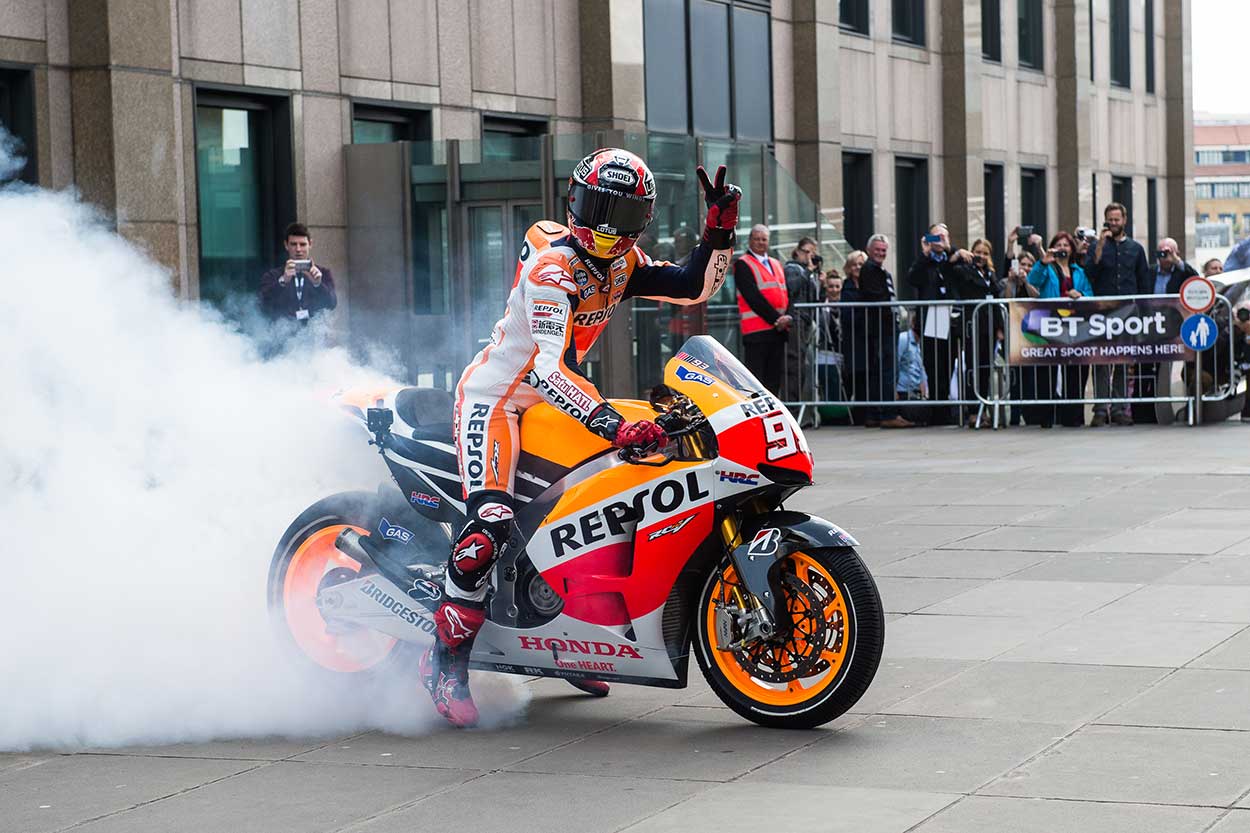Airbox
This is the part of the motorcycle where the filter or air filters are located, supplying air to the motor. In a MotoGP engine, after the airbox we find the injection bodies. This part is located in the space between the seat and the handlebars where street bikes have the fuel tank.
Apex
The innermost point of the line of a curve. Depending on the shape, the location of the apex may vary. In MotoGP, the apex is usually the point at which the rider must start accelerating to lift the bike as fast as possible. Taking the correct line through the apex is known as “hitting the apex”, while failing to find this point would be “missing the apex”.


Average speed
This is the result of calculating the speed based on the race or lap length and the time necessary to complete it. Average speed data is usually given along with the total race time, lap times, and poles, and can be found in the results section of www.motogp.com
atm
Atmospheres, a pressure measurement unit. 1 atm is the amount of pressure exerted by the Earth’s atmosphere at sea level and is equivalent to 1.01 bar, 1.03 Kg/cm2, 14.7 Psi, or 760 mmHg. This term is more commonly used to refer to high pressures in gas tanks.
Banking
The height difference between the outside and the inside of a turn. Those that are higher on the outside are said to have a positive banking, and in the opposite case, they have a negative banking. Turns with a positive banking are easier to take, while those with a negative banking tend to take you out of the turn and away from the apex.
bar
Although we know a bar as the place where we watch the races while we have drink and a bite to eat, it is also a unit of pressure, like the atm we mentioned before. The word originates from the Greek báros, which means weight. A bar is equivalent to 14.5 Psi, 0.98 atm, 1.02 Kg/cm2, or 750.06mmHg. The tyre pressure of a MotoGP bike is supervised by Michelin technicians.


Box, boxes
The boxes are the garages where the teams temporarily assemble their work area and store their tools. We can find them next to the pit lane and the paddock. They are completely adapted to the needs of the riders and mechanics depending on the available space in each layout. There are usually several on a circuit, and they have a water, electricity, and compressed air supply.
Blistering
The appearance of blisters caused by the tire burning at excessive temperatures. Blisters can appear on the outer or inner surface of the rubber when there is overheating and in severe cases pieces can break off, causing total tyre failure. It is not very common in motorcycling, but we have seen cases on some circuits such as Phillip Island during the 2013 Australian GP.
Bodywork
This is the set of covers and elements that make up the body of the vehicle and give it its external shape. In MotoGP, it is almost completely made of carbon fibre and it is meticulously designed to achieve maximum aerodynamics.


Brake caliper
This is the part of the brake where the pistons are situated. In the case of the front brakes, it is attached to the fork, and in the case of the rear breaks, to the swingarm. The brake calipers are usually made of aluminium and are supplied by Brembo as part of the sets available to the teams.
Brake disc
This is the part of the brakes that rubs against the pads to slow the vehicle down. Nowadays, they are manufactured with a carbon compound for both normal and rainy conditions. The discs need a minimum temperature of approximately 200°C to work properly, although they have a very wide operating range. However, in very cold conditions they are covered with protection to keep them within the optimum range.
Brake pads
These are located between the caliper and the brake disc, parts which we have already mentioned. The brake pads are used to grip the disc and cause braking by friction. Just like the discs, they are made of carbon compounds and need a high temperature to work properly. They have a very short life span due to the punishment they undergo during each GP.
Braking marker
This is a visual reference that riders use to know when to start braking on a turn. They can be elements such as posters, trees, stands, or other details that are fixed and serve as a point of reference. These indicators are essential to guide the rider when going at very high speeds. Some circuits have signs that show the distance remaining to the next turn.


Burnout
Burnout is a manoeuvre that consists of skidding the rear wheel while the vehicle is stationary and squeezing the front brake hard to avoid losing control of the bike. This causes a lot of smoke and heats the tyre. Although burnout can be a good way to heat the tyre, it is common for riders to do so only as a form of celebration as it also puts strain on the rubber, transmission, and engine.
Butterfly
In mechanical terms, a butterfly is a valve that allows the passage of air. This type of mechanism is important in such key areas as the engine intake system, and opens or closes depending on the accelerator. In MotoGP each cylinder has its own intake butterfly and each one can be opened independently. Butterflies are not the only type of valve that we can find in an engine, there are also very advanced pneumatic valves.


 Join Us
Join Us  Join Us
Join Us 

Zaproxy dolore alias impedit expedita quisquam.